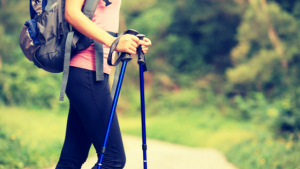Do I Need Trekking Poles?
By Leandra Beabout
(Leandra Beabout is an experienced freelance travel and lifestyle journalist who has written for Fodor’s Travel, The Everygirl, Dame Traveler, and more.)
Maybe you’ve wanted a pair while clambering down a muddy ridge. Or you’ve watched friends use them to cross slippery streambeds. They’re for stability, sure, but you’re still wondering—do hikers need trekking poles?
Here’s all you need to know to decide whether trekking poles are necessary for your next adventure.
What are trekking poles?
Trekking poles are essentially ski poles for hikers. Sold in pairs, they’re adjustable to suit hikers of all sizes and heights. Of course, some hikers prefer single poles, known as hiking staffs. Hiking staffs don’t provide much support, so they’re best for walks on flat terrain.
How do trekking poles help?
 Most hikers use trekking poles to redistribute weight from their knees or ankles on steep hills. But this simple, lightweight equipment packs in several more benefits.
Most hikers use trekking poles to redistribute weight from their knees or ankles on steep hills. But this simple, lightweight equipment packs in several more benefits.
In 2010, a research team at Northumbria University rounded up 37 people and asked them to hike up and down Snowdon Mountain, a 3,560-foot peak in Wales. The catch? Only half the climbers got trekking poles.
After recording heart rates and exertion levels on the trail, then surveying hikers for three days after, the benefits were clear: The hikers with poles had more endurance and energy. And for days afterward, backpackers without poles suffered much more muscle soreness.
The other benefits?
- Joint pain relief. Even if you’re in great shape, pounding the trail can be rough on your joints. Poles help absorb your body weight.
- Better stability. Trekking poles connect you to the ground in two other places. Imagine the difference between a two- or three-legged stool and a chair.
- Injury reduction. When you’re stable and sure-footed, you’re less likely to twist an ankle or stumble.
When should you use trekking poles?
 Stop and think about your upcoming hikes. Now ask yourself, “Do I deal with chronic joint issues? Will the trails be steep or slippery? Will I carry a heavy pack?”
Stop and think about your upcoming hikes. Now ask yourself, “Do I deal with chronic joint issues? Will the trails be steep or slippery? Will I carry a heavy pack?”
In other words, ask yourself if you’ll need a strength and stability boost. Here are some of our favorite times to use trekking poles:
- Traversing streams and slick, muddy terrain
- Climbing up or down steep inclines
- Hiking slippery winter conditions, including checking the strength of frozen streams or ponds
Sometimes trekking poles aren’t necessary for the trail ahead. Maybe you want to travel light and equipment-free. Maybe you’ll mostly be hiking on a valley floor or through flat meadows. Or maybe you prefer to rely on core strength rather than arm muscle while hiking. The choice is yours!
You can find the best hiking gear and apparel at Alabama Outdoors! We want everyone to enjoy the outdoors, and we work to build loyalty one connection at a time. Take advantage of our shipping, curbside pickup, or home delivery services or make an appointment for a virtual shopping trip today! #BeOutdoors